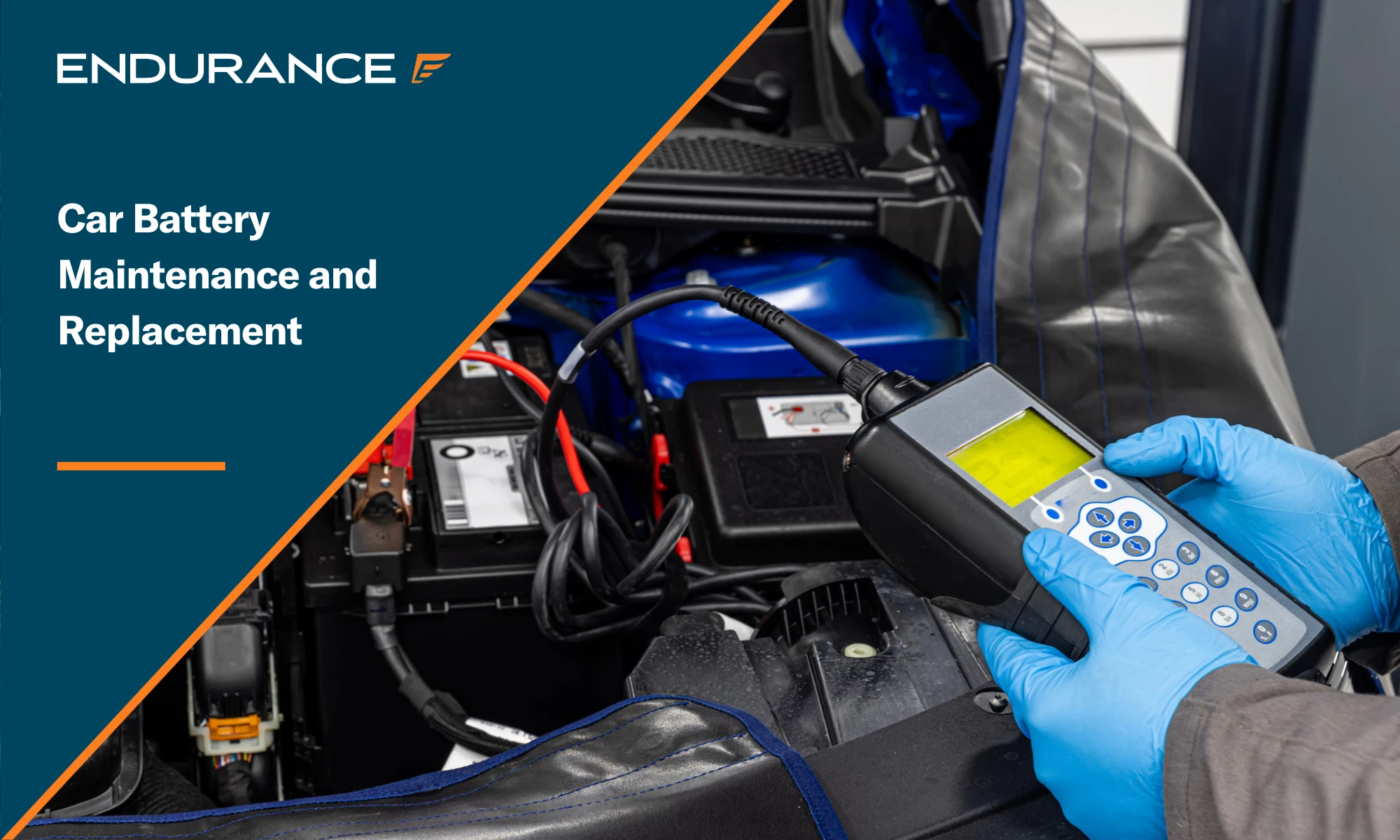Get this deal! Call now.
Speak with a vehicle protection plan specialist and get $450 off any new contract instantly during Black Friday/Cyber Monday Sale.
Call 866-678-4172
or scan the code below


The last thing you need when heading to work, picking up the kids, starting a road trip, or just leaving the house is to be stuck with a car that won’t start. Nothing will put a damper on your day like a dead battery. Luckily, with just a little bit of routine maintenance and the occasional replacement, you can extend the life of your vehicle, avoid inconvenient breakdowns, and know when it’s time for a battery replacement. Learn everything you need to know to keep your vehicle powered up and ready to roll.
The battery within your vehicle is more than just a power source. It is the heart of your vehicle’s electrical system. The battery supplies this system with the crucial jolt of electricity it needs to start the engine and then powers everything from your headlights and dashboard to your radio and windows. Without a healthy battery under the hood, your car simply won’t run.
Car battery maintenance is important, though, as it helps to extend the battery life of your vehicle. Simple actions like cleaning the terminals of the battery and checking its voltage can help your battery last closer to five years as opposed to sputtering out at two to three years. Additionally, this type of maintenance can help you prevent unexpected breakdowns by catching problems early. Above all else, though, battery maintenance will save you money. They aren’t cheap, and neither are towing services on missed workdays, so just a few minutes of maintenance now can help you avoid those frustrating expenses.
Batteries rarely die without any warning unless you do something like leave your headlights on overnight. More often than not, a battery will show signs of trouble before completely giving out on you.
Keep an eye out for the following red flags that signal your car battery needs replacing:
If you choose to ignore some of the above signs, your automotive battery may die on you unexpectedly and leave you stranded, potentially unsafe.
One of the most important maintenance tasks to take care of to keep your battery in working order is to clean the car battery terminals. Any corrosion on your battery terminals can interfere with the flow of electricity, but cleaning them is quick and easy, luckily. To get started, you will need safety gloves, a wrench, baking soda, water, a wire brush, a clean rag, and terminal protector spray.
Follow the steps below on how to clean battery terminals:
Generally speaking it’s advised to handle this maintenance every 6-12 months or whenever you happen to notice a buildup under the hood.
Beyond just cleaning your car battery to see if you have a weak battery, you should also ensure that it retains the right amount of charge that it needs. To do this, grab a multimeter from the nearest hardware store or a similar battery tester. If using a multimeter, set it to 20 DC volts and turn off your car. Pop the hood and connect the red probe on the multimeter to the battery’s positive terminal, then the black probe to the negative. Below is how to interpret the output:
Other battery testers can also measure cranking amps as well as overall battery health. Some even offer printouts of your battery status, which can help you narrow down its health even further.
In the event that you find out after testing your battery that it needs to be replaced, it’s important to handle it both safely and correctly. To do this, you will need safety gloves and goggles, an adjustable wrench, a battery terminal cleaner, and a new battery of the correct size and specifications.
Once you are prepared, follow the steps below to replace your battery:
By knowing when you’re likely going to need to replace your car battery, you can get the ball rolling by purchasing and installing the new battery before your old one actually dies and leaves you stranded somewhere. Be aware that extreme hot or cold can evaporate your battery fluids or slow the chemical reactions, respectively. Also, frequent short trips don’t allow the battery to be adequately recharged by the alternator, and long periods of disuse will result in the battery discharging naturally over time. Finally, running lots of accessories constantly can also strain your battery.
If, in conjunction with all of the above, your battery is reaching the three-year mark, you should begin to monitor its health more closely. Fall and spring are great times for battery inspections, especially if you live in an area prone to temperature swings.
While a car battery is typically considered a wear-and-tear item and not covered under most warranties, many related electrical components that can fail or be damaged are eligible for coverage. This is where an extended warranty, more accurately called a vehicle service contract (VSC), can provide valuable protection. Endurance Warranty offers several auto protection plans, including the Superior, Supreme, and Secure Plus plans, which can cover critical electrical components such as:
Each of these components is an important part of your vehicle’s electrical system, even if it isn’t the battery itself. With an extended warranty in place and regular battery maintenance, you can keep the entire battery system operational for years to come.
While your car’s battery may not seem important at first glance, the minute it stops working, you realize just how crucial it is to your vehicle. With regular inspections, clean terminals, voltage checks, and timely battery replacements, you can avoid being stuck in a parking lot with a dead car. Always check your battery regularly and replace it when you notice the key signs that its lifespan is beginning to deteriorate.
On top of this, consider adding an extended warranty or vehicle service contract so that you can protect the electrical system of your vehicle even more. To learn more about which Endurance plan may suit your needs, contact one of our plan advisors at (800) 253-8203 or request a FREE email quote. You can also see your price and your plan recommendations right away on our online store.

We've received your vehicle information and will contact you shortly with your quote.
— OR —
Start shopping for a coverage plan now.

We're here to make sure you get the most comprehensive EV protection. That's why we've partnered with Xcelerate Auto to offer you transparent and dependable Tesla coverage.
Want us to contact you about XCare coverage for your Tesla?



Your protection is our top priority. Your quote is in progress and you will
receive a confirmation
email shortly.


Speak with a vehicle protection plan specialist and get $450 off any new contract instantly during Black Friday/Cyber Monday Sale.

Save $450 during Black Friday/Cyber Monday Sale!
By clicking the button, you consent to Endurance using automated technology to call, email, and text you using the contact info above, including your wireless number, if provided, regarding auto protection or, in California, mechanical breakdown insurance. You also agree to the Endurance Privacy Policy and Terms and Conditions. Consent is not a condition of purchase, and you can withdraw consent at any time. Message and data rates may apply.


Speak with a vehicle protection plan specialist and get $450 off any new contract instantly during Black Friday/Cyber Monday Sale.
Call 866-678-4172
or scan the code below



Simply fill out the information below and we will follow up fast with your free no-obligation quote.
By clicking the button, you consent to Endurance using automated technology to call, email, and text you using the contact info above, including your wireless number, if provided, regarding auto protection or, in California, mechanical breakdown insurance. You also agree to the Endurance Privacy Policy and Terms and Conditions. Consent is not a condition of purchase, and you can withdraw consent at any time. Message and data rates may apply.

To speak to a vehicle protection plan specialist and save $450 during Black Friday/Cyber Monday Sale
Scan the code below
With over three decades of professional experience in the automotive industry, Dario brings a wealth of knowledge and expertise to the Endurance team. He hails from Argentina, where he received his technical trade education and pursued mechanical engineering. Read more about Dario.